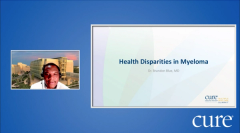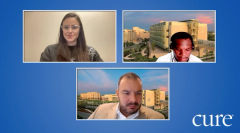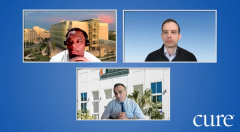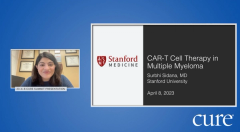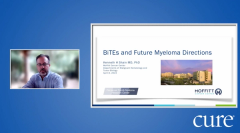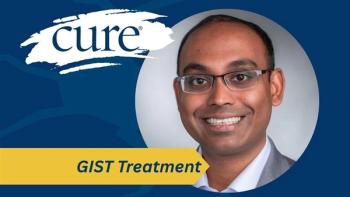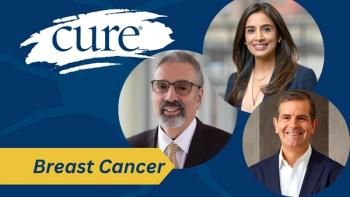
Educated Patient® Multiple Myeloma Summit On the Horizon Panel: April 8, 2023
Watch Dr. Brandon J Blue, Dr. Surbhi Sidana, Dr. Kenneth H. Shain and Mary Derome answer questions about the future of treatment during the CURE Educated Patient Multiple Myeloma Summit.
Episodes in this series

The Myeloma Management Panel was moderated by summit chair Dr. Brandon J Blue, a clinical instructor in the Department of Malignant Hematology at Moffitt Cancer Center, and included Dr. Surbhi Sidana, assistant professor in the Department of Medicine in the Division of Blood and Marrow Transplantation & Cellular Therapy at Stanford University School of Medicine; Dr. Kenneth H. Shain, an associate member in the Malignant Hematology Program in the Department of Malignant Hematology, Tumor Biology, and the Chemical Biology and Molecular Medicine Program at Moffitt Cancer Center; and Mary Derome from the Multiple Myeloma Research Foundation.
Blue: Thank you everyone and welcome, Mary, to this question and answer session. We have a lot of good questions. And so hopefully we can get some good answers.
One of the questions, I'll kick it to Dr. Sidana, patients who right now are getting (CAR-T cell therapy) have typically had experience with transplant in the past. One of the main questions that patients want to know is, how will CAR-T make them feel? You know, we use words like CRS or cytokine release (syndrome), or neurotoxicity. But people want to know, how will it make them feel? Can you speak to that? Or what do you tell patients?
Sidana: Each individual patient's experience is unique and different. And we cannot predict how each person will feel but what I can talk about is averages, like what people in the past have reported, on average, how they feel, and hopefully many people will follow that trajectory or even better. So when we ask patients who got (CAR-T cell therapy), and you know, the first month or two after CAR-T (treatment) doesn't matter, you're getting CAR-T for myeloma or lymphoma for the most part. In fact, myeloma may be even easier because some of the side effects like cytokine release syndrome are less severe. When we asked (patients), they said yes, their quality of life, mainly related to what they could do physically in terms of walking, running, climbing stairs, or functional quality of life, you know, shopping or doing chores at home did go down, they were not able to do as much, and the worst part was at two weeks after the CAR-T (cell treatment). But by one month after CAR-T (treatment), (quality of life) started to recover almost back to their baseline for most patients. And by two months, it was mostly recovered. And when we try to compare it to the autologous transplant, which many patients have had, the change in quality of life, their fatigue, the energy level drop was much less than the auto transplant. So someone's had an auto transplant, I also tell my patients, in terms of energy level drop, each patient is different. But on average, most people don't feel as tired. For as long as with the transplant, the blood counts do go down, but not as low as the transplant. And I think overall, in my experience, most people tolerate (CAR-T cell therapy) much better than transplant in terms of just energy level, fatigue and general feeling of you know, tiredness.
Shain: One of the things that I look at is, again, every patient is unique. When you think about transplant, we kind of have certain cut offs, where we don't want to do transplant, you know, age of 75, and certain kinds of physical restraints in a person, frailty, those things really, they're very different for CAR-T. We've (administered CAR-T cell therapy) in 80-plus year olds. These are different, it's a different story. So again, we'd rather not have cytokine release syndrome or neurotoxicity. But these are things that patients can overcome. I think we did a great job. After about a month, you'll do a lot better. And again, being off therapy is when you talk to these patients that have been on therapy now for five, six, 12, 18 months. It's like they've been on therapy for years. And it's a great reprieve. So I think those are things just want to make sure we are always thinking about when we talk about CAR-T (cell therapy).
Blue: Yeah. So that actually brings me to the next question that I'll kick this to you. One of the questions is, who gets to choose if a patient gets CAR-T or a BiTE (therapy)? Is it the patient? Is it the doctor? What should a patient consider when they're trying to make this decision?
Shain: Well, one, it's always the patient, because we're just navigators, right? We're just here to give direction and give you options and give you numbers, and then give you our experience. But it's a team effort. It's a clinic, a patient, family member, and then a physician decision. And, as I kind of alluded to in my talk is right now, if you're eligible for both, we kind of prefer CAR-T cell therapy first if we can, just based on the data we have today, (rather than) in our back pocket.
But it also depends on how your disease is doing. Do you have time to wait? Do you have time to have cells manufactured? Are you in a place to wait for those things? So there are a number of things that kind of go on into that decision making process? And there is no wrong or right answer if you ask me because they're both outstanding.
Kind of parallel ways of doing things, like is CAR-T (cell therapy) better than BiTE because I don't know. I would say there's pros and cons to both. So those are the things that we have, to make a decision together, and it comes down just like every other therapy. What is the patient need? What does the family need? What are the ability to get things done? And what's the best thing for the patient at that time? So that's kind of my way of looking at it, but there is no absolute right answer.
Blue: Thank you. Mary, I'll jump to you for this next question. The question says, Is there a resource where patients can know If any of these CAR-T or bi-specific (therapies) are happening somewhere close to their area, and which type of treatment those facilities may offer?
Derome: So I mean, there's plenty of resources out there. I would say that if you live anywhere near a major academic medical center has a myeloma program, that you probably would have a good shot at being able to get a CAR-T (therapy) there. Certainly, we encourage folks to give our Patient Navigation Center a call and talk to them about where they're located and whether or not there's a CAR-T program near where they live. So they are available from 9 o'clock in the morning till 7 o'clock at night, Monday through Friday. We have four oncology professionals that staff our Patient Navigation Center, and they can be reached at 888-841-6673. Or you can actually email them as well and their email address is
Blue: Perfect, that kind of segues to another question that was out there. People wanted to talk to someone who's had a prior CAR-T (therapy) or had a prior bi-specific Do you know where patients can go to talk to someone who's had these therapies?
Derome: Absolutely. So certainly talking to the Patient Navigation Center is really useful in this as well. But even more useful is that we have a program at the MMRF called the Myeloma Mentors Program. So these are specially trained myeloma patients and myeloma caretakers, who can talk to other patients and caretakers about experiences that they've had. So on our website, we do have a web page for myeloma mentors. And we have about a dozen of these people. You can go on the page and read about them, we have pictures and a small biography, and it shows types of treatments that they've had. So if you want to talk to somebody who has had a CAR-T (therapy) or somebody who has taken bi-specifics, you can go and read the biographies and see if there's somebody there who matches that description. And then you can actually yourself set up an appointment with them. This is a phone-based program, and I think we have a Calendly to set up this appointment with a myeloma mentor, or if you feel better actually talking to one of the folks at the Patient Navigation Center about setting up an appointment, they can also do that for you as well.
Blue: All right, perfect. Dr. Shain, I'll send this next question over your way. The question was, after patients leave the hospital, when they get the bi-specific treatments, what should patients look for once they get home and these treatments are done as an outpatient? What should they look out for?
Shain: I'm going to do two things. Well, I'm going to answer that question in a second. But I also want to tailor off of Mary's comments that I think one of the things that MMRF and Mary and other groups like it have done, it's created a great grassroots infrastructure for patients, whether it be support groups themselves, whether it be phone calls, and mentors, you know, you have access to these things. So please, you're not alone. You have lots of (people) who are out there trying to help you, because they've already done this. So they've been through this, and the journey is going to all be different, so it's important. So reach out to those support groups and things like that. I don't know how it is for other diseases. But I've always been in remark. It's always remarkable how I think this rare disease, it's just an amazing job that making sure you guys have access to different things like this talk, but everything else like that in your own community. So that's just one to finish that up.
Now, what happens when you get home after your bi-specific therapy is really, you know, you're going to continue on, as you've had therapy really stepped up, you've received most of your doses; you've had CRS or didn't have CRS; you may have had some mitigation strategies utilized on you, there's still a small chance of having some cytokine release. But really the big things for us are, what are the side effects of therapies? How do we monitor and make sure we're protecting you from the potential low immune system you're going to have going forward? But really, it's not that different than everyday therapy. It's the same stuff you've been on and experienced along the way. Right now, the system IV is a weekly dosing strategy. Again, there may be some wiggle room as we get further response-based on patient and physician discussions. But it is how do we help take care of you, it's looking out for fevers, looking out for fatigue, letting us know what's going on. How do we need to maybe spread out the doses or hold doses? These are all things we need to really address with you, but it's not that dissimilar when it's working. It's still disease-related issues that are going on, because this is late relapse disease at this point in time, but that's my way of looking at your play on a little extra protected medications. … You might get once a month that helps give you other people's antibodies to build up that part of your immune system. It's an additional hurdle that we are utilizing more and more with these therapies. But I think really, it's us tracking you, but making sure you inform your physicians or your nurses and your nurse practitioners … to make sure they're aware so we can all help you make the right decisions and get things evaluated more quickly, etc.
Blue: Yeah, and I agree, I definitely think that there's so many resources that are out there that, you know, I really encourage everyone who's listening to really try to do their best to take advantage of those. Dr. Sidana, I think this next question might be best for you. During your talk, you mentioned about the availability of commercial CAR-T getting better. People want to know if they are already on a waitlist, where they were told there would be a long wait, what can they do? Or can they get on a second waitlist to help? What are your thoughts on someone who's been who's on a waitlist and told it they had to wait? What options do they have?
Sidana: First of all, I would like to acknowledge how challenging it is to be on a waitlist like that when you need a treatment. And I can imagine it's very nerve racking. We are frustrated on this side. But I can't even imagine on the other side, what patients go through with the uncertainty. So we acknowledge that it's very hard, and we are doing everything to advocate, working with our pharma companies to shorten those waitlists. So I think yes, while the pharma company may or may not want you to be on two or three different waitlists as a patient, I encourage you, if you have access to different centers, go to different centers, because not only the commercial waitlist, they may have clinical trials of similar or even more promising parties, that you might be able to access sooner than commercial CAR-T. And that just increases your options, you might not choose to do that, depending on, you know what the trial is. But I would say if you have access to say two centers in the Bay Area, UCSF and Stanford very close by we have patients always cross listed, you know, because we might have some trials that others don't, or we might have a slot open up last minute, because some patient couldn't move forward that we could give to another patient. So I would say, if you live in an area that has multiple centers, it does not hurt to go and be, you know, seen by or be on the waitlist for multiple centers. You have to advocate for yourself.
Shain: There's not enough CAR-T cells for the patients that are out there today.
Blue: Yeah, that's exactly right. We as the people taking care of them, we just want people to get better and to get their disease under control. And so whatever mechanism we have available to do that is really what should be done.
We have time probably for one last question, I'll ask you guys a question that we've been asking a lot of the different presenters that have been coming throughout the day. So earlier in the day, one of the things that was brought up as an exciting clinical trial that is basically putting head-to-head transplant versus CAR-T therapy. And so some of the other presenters were very excited about this research. And they predicted which side or therapy that they thought may have the best benefit to patients. And so I asked you all, if you have a potential winner that you think may be the best outcome if put head-to-head, you know, CAR-T versus transplant, what is your predicted winner? And so, Dr. Shain, I see a little smirk on your face. We're not going to hold you to this. But the research is still yet to be done. But do you have a projected winner who you might say, “Hey, I think this is really going to beat the other one out.”
Shain: So I'm going to put out this caveat first. We've been trying to get into trance high dose therapy and autologous stem cell transplant for like 30 years we haven't gotten rid of. It's still a critical part of everything we do for patients that are newly diagnosed and eligible. But the day I can stop having people get high-dose melphalan they can do something better and smarter that might be more effective because they will be happiest and if that happens to be a bi-specific or CAR-T I will be applauding that left and right. Don't tell our transplant friends I said that but they're getting the CAR-T so the same thing. I just made a bet. I'm going to bet on CAR-T because you know the first time I gave my patient CAR-T … her disease went away in five days. Nothing else does that. I mean it's not always experienced, not everybody responds that well, but there's nothing I've seen that can do more of that fast and use your own harvested T cell so if you're asking me what I think is going to happen, CAR-T will. But I don't think it's the only thing. There'll be a little bit more involved in that.
Blue: Alright, Dr. Sidana, do you have a projected winner?
Sidana: Yeah, I think I agree with Dr. Shain. We wish transplant was not something we needed to do for our patients because of the side effects. But really, it does have such amazing outcomes that we've been doing it. So if something can beat that and has less toxicity and side effects, that's great. So I hope CAR-T is that but I think there's going to be a twist. There's patients who have standard-risk disease on average where the remissions with transplant last six, seven years. I think it's a question of transplant versus CAR-T. But then there's patients with very high-risk disease but even the best of our treatments, transplant dual maintenance, remissions only lasts one or two years there. I think we will be following a sequential approach: CAR-T and transplant tandem one after the other, I don't know which is better in CAR-T first or transplant, you know, transplant first because we don't want to wipe out the CAR-T cells with the chemo for the transplant. So I think this is what I think the next 10 years from now. That's what we'll be doing, perhaps: I hope CAR-T for the standard risk, and then a tandem approach for the high risk.
Blue: Perfect, fantastic. And Mary, I'll leave the last question. Where can people get resources about the MMRF and about things to help one more time before we end the talk today?
Derome: So we have a great education resources webpage on our website. So you can go to the website and the address for that is www.theMMRF.org. And there you can see, you know, just all the resources we have. We have podcasts that are talking to patients about stem cell transplant, CAR-T and other therapies. We have infographics, we have patient kits that have really nice brochures that explain a lot of things about multiple myeloma, and recordings of all of our patient summits, our webinars, our Facebook Lives, all of our things that are recorded there, and also little videos that talk about things like bi-specific antibodies and CAR-T therapy and stem cell transplant. So lots of resources.
This transcription was edited for clarity.
For more news on cancer updates, research and education, don’t forget to

